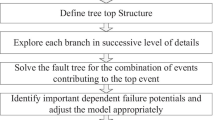Abstract
The monitoring system is a critical function in modern underground mine gas accidents prevention. As a complex dynamic critical system, its fault diagnosis is generally based on the traditional two-state fault tree. In order to solve the problem that the model can only deal with two-state problem, a fuzzy Bayesian network (BN) is used to deal with the polymorphic fault tree. A Bayesian model of the fault of the multi-state gas monitoring system is constructed for machine learning and optimization. On this foundation, the model is validated and applied to a real system. Combined with the fuzzy fault tree importance algorithm, the reliability analysis which has guiding significance for improving the reliability of the gas monitoring system is carried out. The top event, the failure probability of each node, and the fuzzy importance and status importance of each factor are obtained respectively through calculating. Finally, the troubleshooting order of all nodes and key troubleshooting nodes are obtained. When the system is in various states, different parts of the system were diagnosed.





Similar content being viewed by others
References
Pramod T (2019) Measurement and monitoring of mine gases. Advanced mine ventilation, Woodhead Publishing, pp 313–323
Muduli L, Mishra DP, Jana PK (2018) Application of wireless sensor network for environmental monitoring in underground coal mines: a systematic review. J Netw Comput Appl 106(15):48–67
Chen W, Jiang X, Li X (2013) Wireless sensor network nodes correlation method in coal mine tunnel based on Bayesian decision. Measurement 46(8):2335–2340
Ding X, Shi L, Han J (2016) The study of cross-layer optimization for wireless rechargeable sensor networks implemented in coal mines Sensors, 16(2)
Zhou G, Zhu Z, Zhang P, Li W (2016) Node deployment of band-type wireless sensor network for underground coalmine tunnel. Comput Commun 81(C):43–51
Yinghua Z, Guanghua F, Zhigang Z, et al. (2012) Discussion on application of IOT technology in coal mine safety supervision. International Symposium on Safety Science & Engineering in China
Wu D, Bao L, Li R (2010) A holistic approach to wireless sensor network routing in underground tunnel environments. Comput Commun 33(13):1566–1573
Xie M, Han S, Tian B (2011) Anomaly detection in wireless sensor networks: a survey. J Netw Comput Appl 34(4):1302–1325
Yick J, Mukherjee B, Ghosal D (2008) Wireless sensor network survey[J]. Comput Netw 52(12):2292–2330
Shulei S, Bingyou J, Xiangrui M (2018) Assessment of gas and dust explosion in coal mines by means of fuzzy fault tree analysis. Int J Min Sci Technol 8:991–998
Mottahedi A, Ataei M (2019) Fuzzy fault tree analysis for coal burst occurrence probability in underground coal mining. Tunn Undergr Space Technol 83:165–174
Agrawal V, Panigrahi BK, Subbarao PMV (2015) Review of control and fault diagnosis methods applied to coal mills [J]. J Process Control 32:138–153
Sh L, Jinhui W, Zh G, Ch X, Zh X (2017) A risk assessment method to quantitatively investigate the methane explosion in underground coal mine. Process Saf Environ Prot 107:317–333
Pejic LM, Torrent JG, Querol E (2013) A new simple methodology for evaluation of explosion risk in underground coal mines. J Loss Prev Process Ind 26(6):1524–1529
Yazdi M, Nikfar F, Nasrabadi M (2017) Failure probability analysis by employing fuzzy fault tree analysis [J]. Int J Syst Assur Eng Manag 8(2):1177–1193
Yang JX (2015) The research and development of coal IoT reasoning engine based on XML model. Seventh International Conference on Measuring Technology & Mechatronics Automation
Jo B, Khan R (2018) An internet of things system for underground mine air quality pollutant prediction based on azure machine learning. Sensors 18(4):930–939
Singh A, Kumar D, Hötzel J (2018) IoT based information and communication system for enhancing underground mines safety and productivity: genesis, taxonomy and open issues. Ad Hoc Netw 78(9):115–129
Zhang AL (2017) Research on the architecture of internet of things applied in coal mine international conference on Information System & Artificial Intelligence. IEEE
Wei CH (2016) The problems and solutions of gas monitoring system. Inner Mon Coal Eco (24): 7–8
Yanyan S (2016) Discussion on the problems and countermeasures of the use of gas monitoring system. Jiangxi Coal Sci Tech (04):98–99
Wu H, Yan J (2011) Problems and solutions of gas monitoring system [J]. Ind Min Auto 37(11):98–100
Deng J (2011) Problems in the use of coal mine gas monitoring system and solutions to solve problems Silicon Valley, (15): 103
Lizhong X (1998) Research on a monitoring method for operation reliability of underground monitoring system. J Taiy Univ Tech (2): 94–97
Hongwei W, Gang H, Zhang Y (2005) Research on coal mine safety monitoring substation. Elec Desi Appl (12):102–104
Huiling G, Sh C (2004) Application of coal mine safety monitoring system and analysis of common faults. Min Exp 20(11):43–44
Ping L (2016) Fault diagnosis of gas drainage monitoring system based on support vector machine. Auto Instru (7):50–51+54
Pearl J (1988) Probabilistic reasoning in intelligent systems probabilistic reasoning in intelligent systems: Morgan Kaufmann Publishers, 1022–1027
Cooper GF, Herskovits E (1991) A Bayesian method for constructing Bayesian belief networks from databases. In: Proceedings of the seventh conference (1991) on Uncertainty in artificial intelligence, pp 86–94
Cooper GF, Herskovits E (1992) A Bayesian method for the induction of probabilistic networks from data. Mach Learn 9(4):309–347
Yingqi Z (2011) Reliability analysis of polymorphic hydraulic system based on ts importance and Bayesian network [D]. Yanshan University
Funding
This work was supported by the National Key R&D Program of China (Grant No.2017YFC0804408).
Author information
Authors and Affiliations
Corresponding author
Additional information
Publisher’s note
Springer Nature remains neutral with regard to jurisdictional claims in published maps and institutional affiliations.
Rights and permissions
About this article
Cite this article
Xue, S., Li, X. & Wang, X. Fault diagnosis of multi-state gas monitoring network based on fuzzy Bayesian net. Pers Ubiquit Comput 23, 573–581 (2019). https://doi.org/10.1007/s00779-019-01237-w
Received:
Accepted:
Published:
Issue Date:
DOI: https://doi.org/10.1007/s00779-019-01237-w




